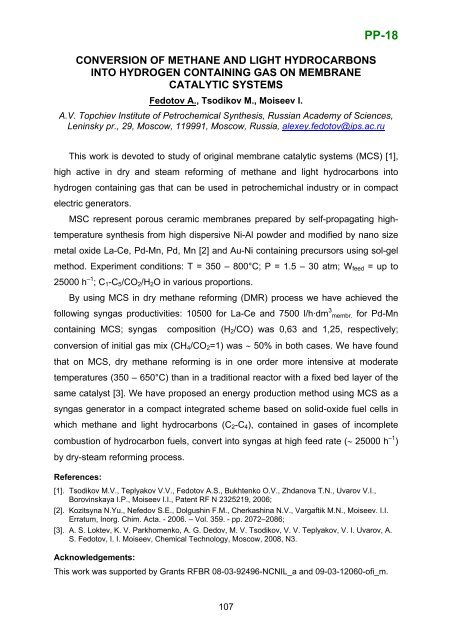Boreskov Institute of Catalysis SB RAS, Novosibirsk, Russia
Boreskov Institute of Catalysis SB RAS, Novosibirsk, Russia
Boreskov Institute of Catalysis SB RAS, Novosibirsk, Russia
- No tags were found...
You also want an ePaper? Increase the reach of your titles
YUMPU automatically turns print PDFs into web optimized ePapers that Google loves.
CONVERSION OF METHANE AND LIGHT HYDROCARBONSINTO HYDROGEN CONTAINING GAS ON MEMBRANECATALYTIC SYSTEMSFedotov A., Tsodikov M., Moiseev I.PP-18A.V. Topchiev <strong>Institute</strong> <strong>of</strong> Petrochemical Synthesis, <strong>Russia</strong>n Academy <strong>of</strong> Sciences,Leninsky pr., 29, Moscow, 119991, Moscow, <strong>Russia</strong>, alexey.fedotov@ips.ac.ruThis work is devoted to study <strong>of</strong> original membrane catalytic systems (MCS) [1],high active in dry and steam reforming <strong>of</strong> methane and light hydrocarbons intohydrogen containing gas that can be used in petrochemichal industry or in compactelectric generators.MSC represent porous ceramic membranes prepared by self-propagating hightemperaturesynthesis from high dispersive Ni-Al powder and modified by nano sizemetal oxide La-Ce, Pd-Mn, Pd, Mn [2] and Au-Ni containing precursors using sol-gelmethod. Experiment conditions: T = 350 – 800°C; P = 1.5 – 30 atm; W feed = up to25000 h –1 ; C 1 -C 5 /CO 2 /H 2 O in various proportions.By using MCS in dry methane reforming (DMR) process we have achieved thefollowing syngas productivities: 10500 for La-Ce and 7500 l/h·dm 3 membr. for Pd-Mncontaining MCS; syngas composition (H 2 /СО) was 0,63 and 1,25, respectively;conversion <strong>of</strong> initial gas mix (CH 4 /СО 2 =1) was ∼ 50% in both cases. We have foundthat on MCS, dry methane reforming is in one order more intensive at moderatetemperatures (350 – 650°C) than in a traditional reactor with a fixed bed layer <strong>of</strong> thesame catalyst [3]. We have proposed an energy production method using MCS as asyngas generator in a compact integrated scheme based on solid-oxide fuel cells inwhich methane and light hydrocarbons (C 2 -C 4 ), contained in gases <strong>of</strong> incompletecombustion <strong>of</strong> hydrocarbon fuels, convert into syngas at high feed rate (∼ 25000 h –1 )by dry-steam reforming process.References:[1]. Tsodikov M.V., Teplyakov V.V., Fedotov A.S., Bukhtenko O.V., Zhdanova T.N., Uvarov V.I.,Borovinskaya I.P., Moiseev I.I., Patent RF N 2325219, 2006;[2]. Kozitsyna N.Yu., Nefedov S.E., Dolgushin F.M., Cherkashina N.V., Vargaftik M.N., Moiseev. I.I.Erratum, Inorg. Chim. Acta. - 2006. – Vol. 359. - pp. 2072–2086;[3]. A. S. Loktev, K. V. Parkhomenko, A. G. Dedov, M. V. Tsodikov, V. V. Teplyakov, V. I. Uvarov, A.S. Fedotov, I. I. Moiseev, Chemical Technology, Moscow, 2008, N3.Acknowledgements:This work was supported by Grants RFBR 08-03-92496-NCNIL_a and 09-03-12060-<strong>of</strong>i_m.107
















